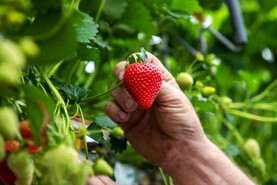Kenya is a country which relies heavily on the fortunes of agriculture. In 2013, 27% of the country’s gross domestic product (GDP) came from agriculture. Furthermore, the sector is the country’s largest employer with over 60% of the working population employed in the wider industry. As a result, agriculture is the backbone of the Kenyan economy.
The climate in Kenya is one of ecological extremes, with land moving from sea level right up to 5,000m. Similarly, rainfall is also variable, from a mere 250mm in the most arid regions to over 2,500mm in the highest rainfall areas.
Land which is considered to be of high potential covers just 12% of the total area and is farmed intensively.
A further 5.5% is considered to be of medium potential, which caters for livestock such as sheep and goats, while the rest is considered to be of low potential. Typically, this land tends to be used for extensive livestock production.
Farm size is also considerably smaller than in Ireland. Many farmers are subsistence-orientated with only a small amount of produce sold for cash. The typical farm has an average of around 2.5 acres. A consequence of this is that land farmed often has to be used much more efficiently than in European countries.
Dairy
Dairy animals typically produce much less milk per head than their counterparts in Ireland. Cows and goats are the main sources of dairy product. Despite the challenging nature of the landscape, there is still the potential to be relatively productive. On a farm owned by Juliana Koki, three cows produce a total of 54 litres per day, with the cows individually hand-milked.
Poultry
Rearing broiler chickens offers high production on a limited land base. In one unit owned by Nancy Mumbua, 200 broiler chickens are produced per month. Chicks are reared in several stages from day-old right through to finishing at six weeks.
One of the main challenges is the high feed costs. Concentrate here is around three times more expensive than in Ireland. To counteract this, the diet is supplemented with cheaper maize meal from the local market in Machakos town. The litter also provides a source of income as it is bagged up and sold to other farmers to use on their maize crops.
Cropping
The main crops used by farmers tend to be maize, beans and peas. Although very few farms are organic, sourcing adequate levels of manure or chemical fertilisers can be challenging due to cost and transport issues. For that reason, legumes are often used in the rotation. Other crops commonly grown here include cabbages, onions and mangoes with drought resistant crops such as sorghum and millet sometimes featuring as well.
Kenya is also a leading producer of tea and coffee with many of our recognised brands sourcing their tea leaves and coffee beans from Mount Kenya. However, production tends to take place on much larger plantations.
Transport woes
Poor rural transport networks are a major issue for farmers. For many, carts pulled by oxen are the only way to transport goods to and from market. Only the main roads are tarmacked and side roads are just dusty tracks. This lack of transport also limits access to fertilisers, vets and any other supplies.
Irrigation
Poor rains means poor crop yield. The major factors that influence the viability of irrigation as an option are access to an adequate water source such as a river or a dam, and also access to finance.
There are many farmers who would like to install irrigation systems but are unable to access loans or savings to do so. Most systems use drip irrigation pipes and require a manual pump to drive water into a water tower that gravity feed the pipes.
Water conservation
With water being such a precious commodity, farmers are keen to find ways in which water can be conserved. One such option is terracing. This is a process whereby the land on slopes is sculpted into steps. This helps to retain soil moisture and reduce soil erosion on exposed slopes. In Machakos County, 70% of the arable land is now terraced.
Water harvesting is also becoming popular. There are several methods used, including creating catchment ponds lined with plastic. While these can help to alleviate the problems of poor rainfall, they are not fool-proof and still dry up in prolonged dry periods. These ponds are used to feed irrigation systems.
Markets
Some farmers sell their produce in co-operatives such as the Katheka Grain Aggregation centre. This allows small scale farmers in the Mwala area to club together and command a better price for their crops of maize, sorghum, millet or cow peas.
Challenges ahead
One of the biggest challenges for farmers is climate change. Low-lying land, arid and semi-arid regions are likely to suffer as a lack of moisture will affect crop growth and forage for grazing animals. However, there is potential for the central highland to benefit and produce more food as a result of more favourable growing conditions.
Another large challenge is finance. While there are options to mitigate against these issues of drought and poor transport, they require funding in order to work. Access to finance would also allow for better provision of education and access to agricultural advisers. This could, in turn, improve future food security.






 This is a subscriber-only article
This is a subscriber-only article













SHARING OPTIONS: